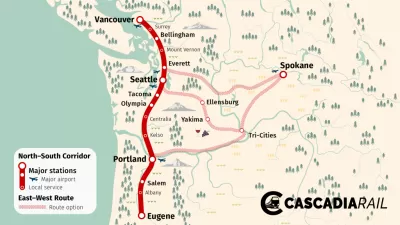The state of Washington is hoping federal infrastructure funding can pay for $198 million of the $348 million necessary to plan the Cascadia High-Speed Rail project.

Legislators in the state of Washington are applying for $198 million in federal funding from the Infrastructure Investment and Jobs act to fund planning work for a proposed 290-mile high-speed rail route connecting Portland, Oregon to Vancouver, British Columbia, with stops along the way including Seattle, Tacoma, Olympia, and more.
Mike Lindblom reports that Washington State legislators sent a letter to U.S. Transportation Secretary Pete Buttigieg making the case for the funding.
Plans call for an electric-powered system that would reach top speeds of 250 miles per hour, according to Lindblom. “The Cascadia high-speed corridor would be faster than any trains that currently operate in the United States, though contractors are now building a starter bullet-train line in central California,” according to Lindblom.
The project is still in relatively nascent stages. “So far, proponents haven’t clearly explained where to place dedicated tracks so they’re apart from other trains, motor vehicles and people, allowing 250 mph travel. That’s what a $348 million planning investment is for,” explains Lindblom.
A report on the project, submitted to the Washington State Legislature in June 2023, estimates the total cost of the project at $42 billion in 2017 dollars. However, an independent legislative review also published in June adjusted the estimate to $63 billion in 2023 dollars, based on construction inflation.
FULL STORY: WA Democrats ask Buttigieg for $200M to plan Canada-Seattle-Portland bullet train

Alabama: Trump Terminates Settlements for Black Communities Harmed By Raw Sewage
Trump deemed the landmark civil rights agreement “illegal DEI and environmental justice policy.”

Planetizen Federal Action Tracker
A weekly monitor of how Trump’s orders and actions are impacting planners and planning in America.

The 120 Year Old Tiny Home Villages That Sheltered San Francisco’s Earthquake Refugees
More than a century ago, San Francisco mobilized to house thousands of residents displaced by the 1906 earthquake. Could their strategy offer a model for the present?

USDOT Repeals Emissions Monitoring Rule
A Biden-era regulation required states to report and plan to reduce transportation-related emissions.

CaBi Breaks Ridership Record — Again
Washington D.C.’s bike share system is extremely popular with both residents and visitors.

San Francisco Opens Park on Former Great Highway
The Sunset Dunes park’s grand opening attracted both fans and detractors.
Urban Design for Planners 1: Software Tools
This six-course series explores essential urban design concepts using open source software and equips planners with the tools they need to participate fully in the urban design process.
Planning for Universal Design
Learn the tools for implementing Universal Design in planning regulations.
Clanton & Associates, Inc.
Jessamine County Fiscal Court
Institute for Housing and Urban Development Studies (IHS)
City of Grandview
Harvard GSD Executive Education
Toledo-Lucas County Plan Commissions
Salt Lake City
NYU Wagner Graduate School of Public Service




























